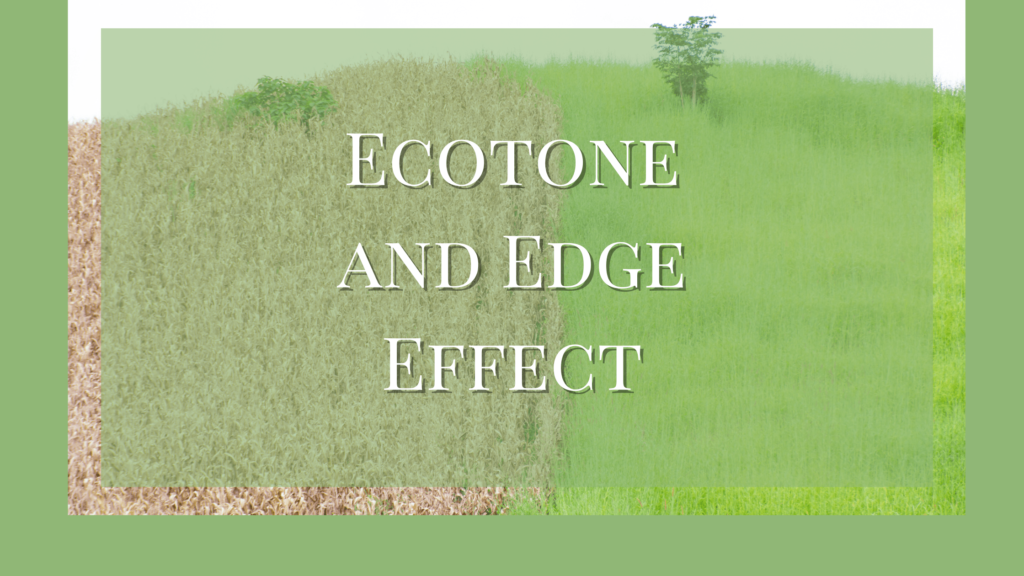Ecotone and edge effect are two fascinating concepts of ecology. While ecotone refers to the transitional community between two ecosystems, the edge effect depicts the changes happening in this community.
What is Ecotone?
An ecotone is the junction where two major communities or biomes meet and blend. It is a transition zone between two or more communities such as forest and grassland, hard bottom or marine communities, etc. An ecotone can be small or large in size.
Ecotone helps with the gradual continuation of one community to the next. Thus it could be defined as the “zone of transition between adjacent ecological systems having a set of characteristics uniquely defined by space and time scales and by the strength of the interactions between the systems”.
The variety and density of life often is greatest in this transition area which is called edge effect. The edge effect refers to the unique environmental conditions and the subsequent dynamics it creates at the boundaries.
The species growing in the ecotone area are often called edge species. The extent of ecotone is variable. It is narrow between a pond and adjacent upland but wide between the evergreen and deciduous forest.
Characteristics of Ecotone
- Sudden changes in an environment can often lead to the formation of ecotones.
- The vegetation here can be narrow or wide. A narrow ecotone is visible between a grassland and a forest while the ecotone between a desert and a forest is often wide.
- Ecotones have intermediate environmental conditions when compared to the communities on either side.
- The quality, quantity, and characteristics of the population change from its core to the ecotone area. Sometimes, there could be organisms that are distinct from those from these communities.
- Ecotones promote diversity as it opens new opportunities for other organisms to come and inhabit these areas. It often supports a higher diversity of species than the adjacent ecosystems alone.
- Ecotones are formed naturally and artificially. An ecotone may be visible between a forest and an agricultural land.
- They are prone to microenvironmental changes and show gradient characteristics. They dynamically respond to every change in the factors such as moisture, temperature, pollution, grazing habits of the animals, etc.
Edge Effect Explained
The edge effect is the change in characteristics shown by the organisms in the ecotone when compared to the respective communities. Such differences between adjacent communities happen due to changes in their environment. These changes occur due to the differences in moisture, light, soil, biotic pressure, exposure, soil conditions, temperature, humidity, and vegetation structure.
The edge effect creates a distinct microenvironment that is different from the interior of the ecosystems on both sides. It favors certain species and allows them to coexist and interact. At the same time, these transitional zones can make some species vulnerable to changes, increase predation, competition, etc.
Importance of Ecotone and Edge Effect
Ecotone serves as a transition zone between two different communities. The characteristics of one community can have a smooth transition into another community because of ecotones.
Ecotone is more sensitive to the changing environment and can protect the communities on either side.
The edge effect phenomenon provides diversity even in this micro-community that helps protect the characteristics of these communities. It shows more population density than the communities on either side.
Conclusion
Conserving ecotones helps maintain biodiversity. Edge effect management includes minimizing the negative impacts by making buffer zones and transition areas.
Both ecotone and the edge effect help preserve the dynamic nature of ecosystems. They are essential to understanding the interactions of organisms at the boundary zone. This will help protect biodiversity and ecological stability.
References
- Shukla, R.S. and Chandel, P.S. (2001) Plant Ecology. S. Chand and Company Ltd., New Delhi.
- Verma, P.S., Agarwal, V.K. (1999). Cell biology genetics molecular biology evolution and ecology. New Delhi: S.Chand Co.(Pvt) Ltd.
- Ecotone and Its Importance





I learned a lot from this article. Keep up the great work!